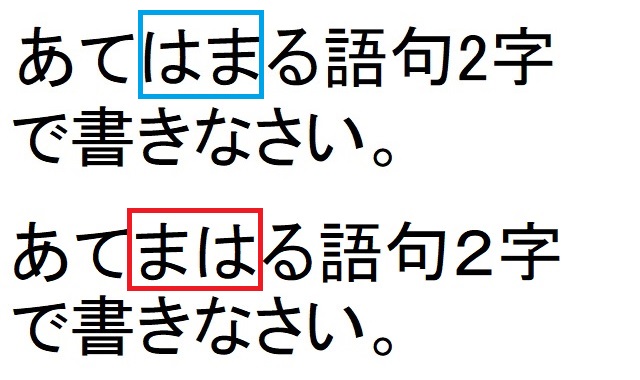
Fukushima Board of Education admits mistake, but it’s hard to imagine it made any difference.
Fukushima recently held its entrance exam for public prefectural high schools, and obviously all of the candidates were trying to answer the questions correctly. That’s usually a lot harder to do, though, when the question itself isn’t correct.
Last Thursday, the Fukushima Prefectural board of Education put out a statement to explain that a misprint in the instructions for a question in the social studies section had been brought to their attention. After confirming that they had in fact goofed up, the board has decided to give all candidates credit for answering the question correctly, regardless of how they actually answered it on the test.
That seems like a fair thing to do. After all, if the question is worded in a way that’s confusing or misleading, you can’t really expect kids to still get the right answer, can you?
Well, maybe you can. The question involved a section from Japan’s constitution, with one section underlined. Students were supposed to look at the underlined section, then write the specialized political term that applies to the underlined portion. The question even gave them a bit of a hint, specifying that the term is made up of two kanji characters.
Written in Japanese correctly, “Please write the applicable two-kanji word” looks like this:
The question students actually saw written in their tests, though, looked like this:
See the difference?
Two hiragana characters have had their order switched. Taken as a set, あてはまる, read “atehamaru,” means “applicable” or “appropriate.”
On the other hand, what was actually written in the test, あてまはる, “atemaharu,” doesn’t have any meaning at all.
Here’s the thing, though. Atehamaru is a phrase that shows up in tests all the time, pretty much in any permutation of “Select the appropriate answer.” It’s a word that students know they’re going to see over and over during their entrance exam before the test even starts, and because atemaharu isn’t a word, it should have been pretty obvious not only that the atemaharu was a typo, but also that it was supposed to be atehamaru.
▼ It’s sort of like if I asked “Which of these is a dog? Please pick the corectr photo.” That typo isn’t going to throw anyone off so badly that they pick the lobster.
Because of that, most Japanese Twitter reactions have been sort of shocked that everyone is getting credit for the question because of the atehamaru/atemaharu slip-up, with comments such as:
“Everyone gets a free point on the test just for that?”
“Makes no sense at all.”
“There’s lucky, and then there’s too lucky.”
“They’re being way too soft on them.”
“I honestly wouldn’t have even noticed the typo.”
“I think it took me 50,000 tries to read it as anything other than atehamaru.”
A few commenters also wondered about the possibility of that free point boosting the score of a student who answered the question incorrectly just high enough to secure admission to a school’s last available seat by nature of compensation for the typo, perhaps denying the slot to someone who had answered the question correctly and thus won’t be seeing their own score raise any higher because of the board’s decision. That would, though, mean that the two students had had equal scores before the free point though, so it would have been an incredibly small margin between the two applicants.
In any case, it’s probably safe to say that the board will be adding an extra round of proofreading checks to its test next year.
Source: Fukushima Prefectural Board of Education, Yomiuri Shimbun via Livedoor News via Jin, Twitter/@livedoornews
Top image: Pakutaso
Insert images: SoraNews24, Pakutaso (1, 2)
● Want to hear about SoraNews24’s latest articles as soon as they’re published? Follow us on Facebook and Twitter!







 Man kicked out of Japan’s national college entrance exam for improper mask-wearing technique
Man kicked out of Japan’s national college entrance exam for improper mask-wearing technique Japanese high schools stop asking students to specify their gender on application forms
Japanese high schools stop asking students to specify their gender on application forms Over half of Japanese students in nationwide test score zero percent in English speaking section
Over half of Japanese students in nationwide test score zero percent in English speaking section “A dead bug” and other amusing, adorable, snarky, and downright ridiculous test responses
“A dead bug” and other amusing, adorable, snarky, and downright ridiculous test responses Work-in-progress Japanese AI program could probably get into 474 universities in the country
Work-in-progress Japanese AI program could probably get into 474 universities in the country How to order snacks on a Shinkansen bullet train in Japan
How to order snacks on a Shinkansen bullet train in Japan Demon Slayer: Kimetsu no Yaiba gets new roller coaster attractions and food at Universal Studios Japan
Demon Slayer: Kimetsu no Yaiba gets new roller coaster attractions and food at Universal Studios Japan New samurai glasses are Japan’s latest weird must-have souvenir
New samurai glasses are Japan’s latest weird must-have souvenir Burger King Japan suddenly adds Dr. Pepper and Dr. Pepper floats to its menu nationwide
Burger King Japan suddenly adds Dr. Pepper and Dr. Pepper floats to its menu nationwide Nintendo history you can feel – Super NES, N64, and GameCube controllers become capsule toys
Nintendo history you can feel – Super NES, N64, and GameCube controllers become capsule toys High-fashion Totoro cuddle purse is like an elegant stroll in the forest【Photos】
High-fashion Totoro cuddle purse is like an elegant stroll in the forest【Photos】 Japan’s new difficult-to-drink-from beer glass protects your liver, but it’s a brutal experience
Japan’s new difficult-to-drink-from beer glass protects your liver, but it’s a brutal experience Kyoto Tower mascot termination reveals dark side behind cute Japanese characters
Kyoto Tower mascot termination reveals dark side behind cute Japanese characters New Pokémon ice cream, dessert drinks, and cool merch coming to Baskin-Robbins Japan【Pics】
New Pokémon ice cream, dessert drinks, and cool merch coming to Baskin-Robbins Japan【Pics】 To combat declining birth rate, Japan to begin offering “Breeding Visas” to foreigners
To combat declining birth rate, Japan to begin offering “Breeding Visas” to foreigners Hello, cosmetics! Clinique teams up with Hello Kitty this summer for first-time collaboration
Hello, cosmetics! Clinique teams up with Hello Kitty this summer for first-time collaboration “The most Delicious Cup Noodle in history” – Japan’s French Cup Noodle wins our heart【Taste test】
“The most Delicious Cup Noodle in history” – Japan’s French Cup Noodle wins our heart【Taste test】 Starbucks releases a cute Frappuccino and Unicorn Cake…but not in Japan
Starbucks releases a cute Frappuccino and Unicorn Cake…but not in Japan McDonald’s Japan’s Soft Twist Tower: A phantom ice cream only sold at select branches
McDonald’s Japan’s Soft Twist Tower: A phantom ice cream only sold at select branches Yabai Ramen: What makes this Japanese ramen so dangerous?
Yabai Ramen: What makes this Japanese ramen so dangerous? Finally! Nintendo Japan expands Switch 8-bit controller sales to everybody, Online member or not
Finally! Nintendo Japan expands Switch 8-bit controller sales to everybody, Online member or not Japanese government wants to build luxury resorts in all national parks for foreign tourists
Japanese government wants to build luxury resorts in all national parks for foreign tourists 10 things you should buy at 7-Eleven in Japan
10 things you should buy at 7-Eleven in Japan Studio Ghibli releases anime heroine cosplay dresses that are super comfy to wear
Studio Ghibli releases anime heroine cosplay dresses that are super comfy to wear Woman charged for driving suitcase without a license in Osaka
Woman charged for driving suitcase without a license in Osaka Studio Ghibli unveils My Neighbour Totoro miniature house model
Studio Ghibli unveils My Neighbour Totoro miniature house model Kyoto experiencing problems with foreign tourists not paying for bus fares, but not on purpose
Kyoto experiencing problems with foreign tourists not paying for bus fares, but not on purpose Fighting mild hunger with a Japanese soda that turns into jelly in the stomach【Taste test】
Fighting mild hunger with a Japanese soda that turns into jelly in the stomach【Taste test】 Studio Ghibli’s Howl’s Moving Castle tapestry unveiled in Japan for first time
Studio Ghibli’s Howl’s Moving Castle tapestry unveiled in Japan for first time McDonald’s new Happy Meals offer up cute and practical Sanrio lifestyle goods
McDonald’s new Happy Meals offer up cute and practical Sanrio lifestyle goods Sales of Japan’s most convenient train ticket/shopping payment cards suspended indefinitely
Sales of Japan’s most convenient train ticket/shopping payment cards suspended indefinitely Sold-out Studio Ghibli desktop humidifiers are back so Totoro can help you through the dry season
Sold-out Studio Ghibli desktop humidifiers are back so Totoro can help you through the dry season Japanese government to make first change to romanization spelling rules since the 1950s
Japanese government to make first change to romanization spelling rules since the 1950s Foreigner’s request for help in Tokyo makes us sad for the state of society
Foreigner’s request for help in Tokyo makes us sad for the state of society Ghibli founders Toshio Suzuki and Hayao Miyazaki contribute to Japanese whisky Totoro label design
Ghibli founders Toshio Suzuki and Hayao Miyazaki contribute to Japanese whisky Totoro label design Doraemon found buried at sea as scene from 1993 anime becomes real life【Photos】
Doraemon found buried at sea as scene from 1993 anime becomes real life【Photos】 Tokyo’s most famous Starbucks is closed
Tokyo’s most famous Starbucks is closed Princesses, fruits, and blacksmiths: Study reveals the 30 most unusual family names in Japan
Princesses, fruits, and blacksmiths: Study reveals the 30 most unusual family names in Japan Public high school in Japan’s Gifu Prefecture will no longer take student absences into account for entrance applications
Public high school in Japan’s Gifu Prefecture will no longer take student absences into account for entrance applications Japanese teacher criticized for attending son’s entrance ceremony instead of her own school’s
Japanese teacher criticized for attending son’s entrance ceremony instead of her own school’s Tokyo public schools will stop forcing students with non-black hair to dye it, official promises
Tokyo public schools will stop forcing students with non-black hair to dye it, official promises Japan’s Shizuoka bans teachers from personal communication with students on social media
Japan’s Shizuoka bans teachers from personal communication with students on social media Students go nearly a year without textbooks after teacher forgets to hand them out
Students go nearly a year without textbooks after teacher forgets to hand them out Japanese teacher beats up student for making fun of his body by calling him anime character name
Japanese teacher beats up student for making fun of his body by calling him anime character name Tokyo Medical University accused of dropping women’s entrance exam scores 10-20 percent each year
Tokyo Medical University accused of dropping women’s entrance exam scores 10-20 percent each year Critically acclaimed A-bomb manga Barefoot Gen excerpts removed from Hiroshima school curriculum
Critically acclaimed A-bomb manga Barefoot Gen excerpts removed from Hiroshima school curriculum Study reveals too much Internet and video games is bad for your grades
Study reveals too much Internet and video games is bad for your grades Don’t like trigonometry? Then you’re just like Hitler, says Japanese high school English teacher
Don’t like trigonometry? Then you’re just like Hitler, says Japanese high school English teacher Social media users boast of plans to grope schoolgirls on day of Japan’s most important test
Social media users boast of plans to grope schoolgirls on day of Japan’s most important test Board of education suspends Japanese teacher who stockpiled 750 pairs of panties at school
Board of education suspends Japanese teacher who stockpiled 750 pairs of panties at school Which one is former Nissan CEO Carlos Ghosn? Japanese students surprised by test question
Which one is former Nissan CEO Carlos Ghosn? Japanese students surprised by test question Japanese rail company lets teens ride for free on super stressful entrance exam days
Japanese rail company lets teens ride for free on super stressful entrance exam days Teacher disciplined for drinking alcohol during class in Japan
Teacher disciplined for drinking alcohol during class in Japan
Leave a Reply